StoryChief Review 2024: Unify Your Content Marketing And Social Media Efforts
Social media and content marketing are key marketing channels that allow you to increase awareness of your brand and attract more customers.
So here’s a crazy idea:
Why not create a tool that seamlessly harnesses the power of both strategies to help grow your small business?
Fortunately, this tool exists: StoryChief.
In this StoryChief review, we will talk about what this software is about, how you can use it to automate all your marketing efforts, and whether or not it’s something that your business should use.
What is StoryChief?
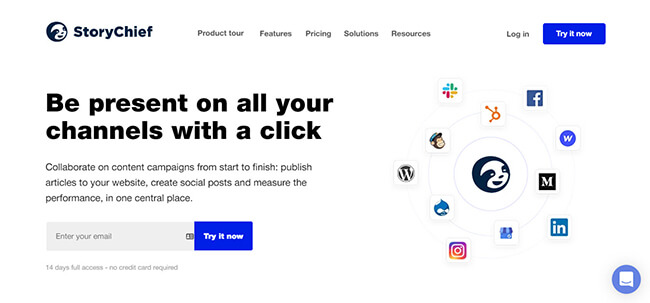
The goal of the StoryChief team is to help a small business such as yours to streamline its content publishing and distribution process. That means putting out their content to different publishing channels and promoting them on various online platforms is done within the tool.
In concept, what StoryChief aims to achieve is a game-changer.
No longer do you have to log in to your blog to write and publish the post, hop on to your online channels individually to promote it, then go to your email marketing tool to write an email blast about it to your subscribers.
Again, this is all in concept. Whether StoryChief pulls it off for users is another story altogether.
And that’s what this StoryChief review is here for. That said, let’s jump right into it!
Features of StoryChief
Since StoryChief works as one tool to manage all your marketing needs, there’s a lot to get through but it’s all straightforward.
Let’s start with the ability to create blog posts using the platform, which will serve as the foundation of your marketing campaign.
Stories
StoryChief runs all blog posts through its William blogging platform. This is where all the magic happens, from content creation to distribution.
Upon signing up for an account, go to “Stories” from the menu and choose “+new story” on the next page.
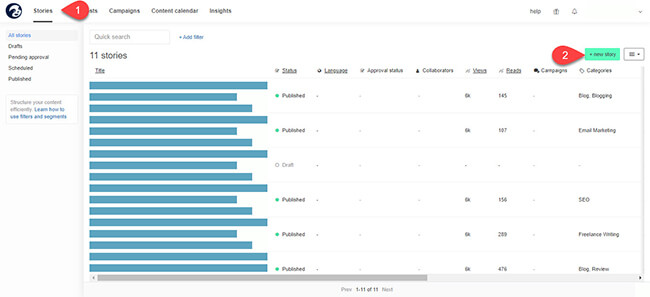
If you’ve created stories or blog posts before, you will see the ones you’ve published on this page and their performance since then. Later on, we’ll discuss how to analyze the data you’ll see here to help you create better posts for your campaigns.
You’ll be brought to the text editor page on StoryChief where you can type in your blog post here. Like WordPress, you can add images, video, and rich media to help make your stories stand out.
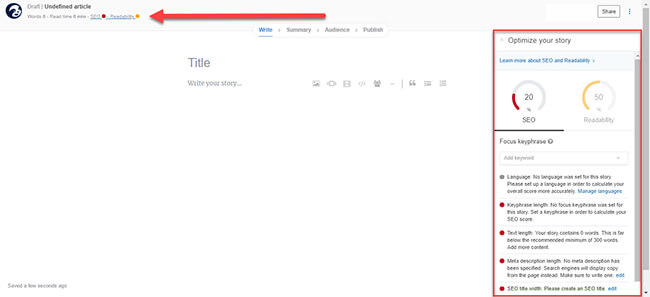
If you click on the SEO and Readability links on the top left of the screen of StoryChief, you will open a section on the right containing information on how you can optimize your content for search engines and readers.
Just follow the suggestions here to help improve your content quality and make it easier for your audience to read.
If you’re reviewing work from one of your content writers, highlight a section of the article you want to leave a comment on. To view all the comments, click on “Comments” on the top right of the screen to open the section on the right side.
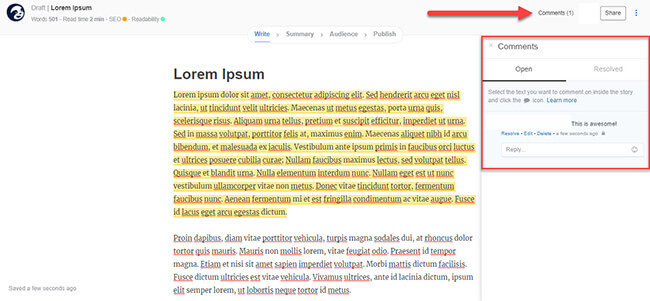
Once you’re done writing your content, you need to create a summary of your post on Facebook, Twitter, and others and see how it would look like once it’s shared there.
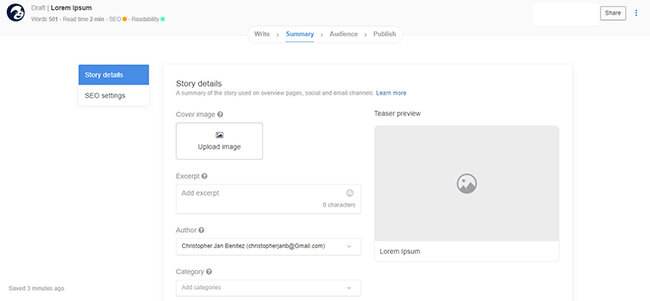
From here, you can also edit the post’s SEO settings like title, meta description, and slug to further optimize it.
Next is where the true power of StoryChief lies. Before you can publish your content, you have the option to share your content on different channels online.
Below are the content distribution channels where you can broadcast your stories:
- Personal websites – William, WordPress, Drupal, etc.
- Content hubs – Medium, RSS feed.
- Referral marketing – Ambassadors, Press.
- Email marketing – MailChimp, Campaign Monitor, ActiveCampaign.
- Mobile platforms – Facebook Instant Articles, Google AMP.
- Social networks – Facebook, Twitter, LinkedIn, etc.
To be able to distribute your content on multiple channels, you need to connect and activate them from the Channels page.
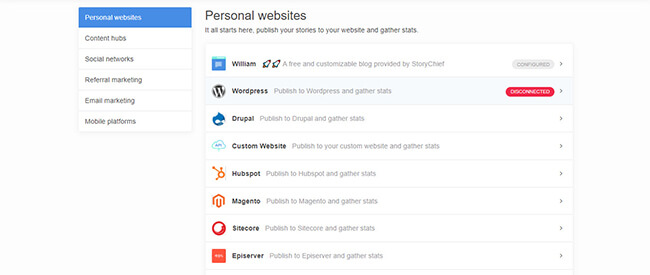
Once you have, you should be able to share your posts on these channels.
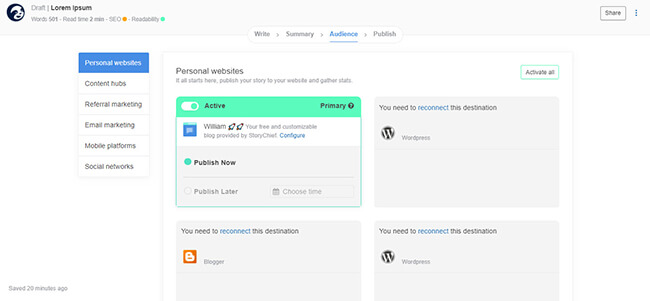
From here, you can decide to share them on your chosen channels immediately after the blog post is published. You can also schedule them appropriately and drip-feed them to prolong the impact of your content.
Finally, click “Publish” to deliver your content to your audience.
As you can see, StoryChief’s easy-to-use interface helps simplify developing and launching your content marketing campaign. Everything you need to get your stories across to your audience is found in this workflow.
Using this tool, there’s simply no excuse to not reach your fans and followers!
Social posts
While not primarily a social media tool, StoryChief nonetheless gives you the option to manage your brand’s social media campaigns.
This is a perfect solution for your team to manage your workflow of reviewing and approving posts without using a separate tool for it.
Upon clicking on “Social Posts,” you will see the “postsets” or the collection of messages you’ve created for your stories.
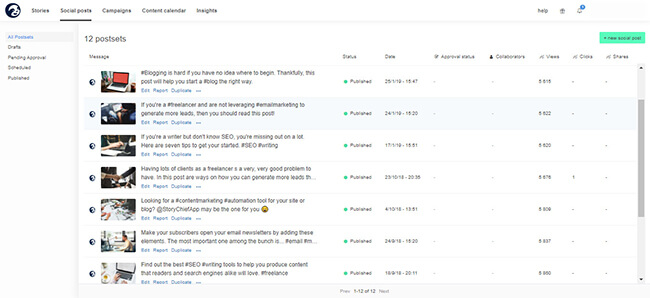
To create a new postset, click on “+ new social post” to draft the messages for publishing across your different channels.
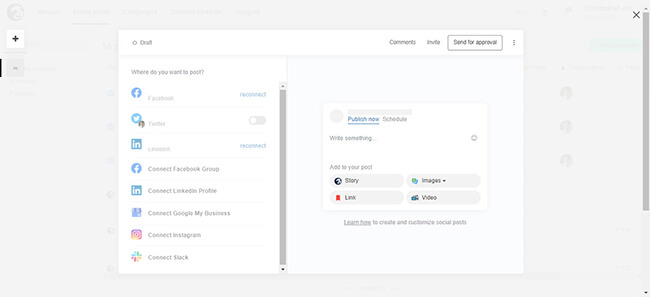
Once the user created the message, click “Send for approval” so you can review and leave comments on the post, if not approve it for publishing.
From the Social Posts page of StoryChief, you can duplicate past campaigns to launch again if they were able to get you more views, clicks, and shares than usual. You can see these factors on the last three columns of the page for each campaign.
Campaigns
Using the tool to manage content marketing campaigns for clients, you and your team can organize the different projects you’re working on and create respective campaigns for each.
Clicking on “Campaigns” lets you enter the details about the campaign you plan on launching.
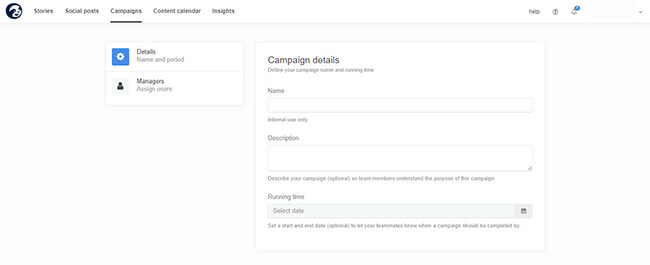
From here, you can add the different users involved in this project to get everybody on board.
Once you’ve set the details, you will be brought to the campaign page where you can find all your stories and posts.
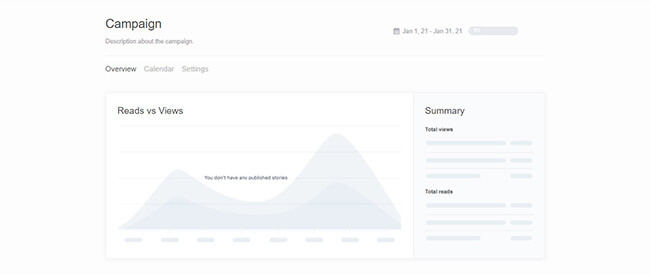
You can also check upcoming stories and posts in calendar view to see your content schedule visually.
Content calendar
Even if you don’t have a campaign, you can see all the content you have published and scheduled so far by clicking on “Content Calendar” on the menu of StoryChief.
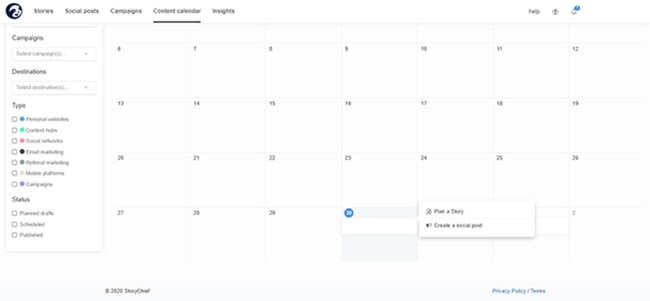
You can filter what you’ll see on the calendar by checking the boxes of the channel types on the left menu or the different statuses of the content (drafts, scheduled, and published).
From this view, you can also plan a story or social posts by clicking on the date of your choice.
Again, this is a great way to visually conceptualize your content marketing strategy for the coming months. You get to see which dates don’t have scheduled posts or stories so you can add them straight from the calendar.
Insights
Once you’ve spent time launching your campaigns, it’s time to analyze their results.
From the dashboard, you can check the overview of your overall reach across all the content you’ve published on StoryChief thus far.
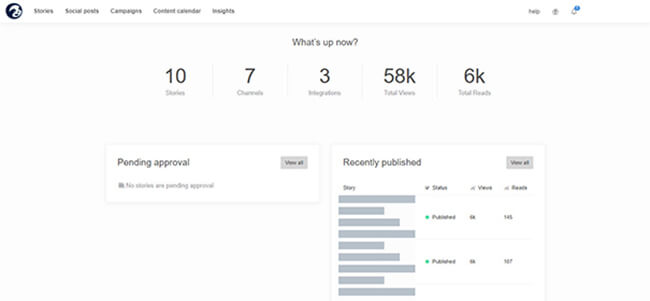
However, to get more specific information about each of your stories and posts, click on “Insights” from the menu.
This allows you to drill down on the most crucial metrics that measure the performance of each content you’ve created.
This feature is available for the Team plan only. Once you sign up for this plan, you can identify your top-performing content based on views, reads, and other variables, track how much of your posts helped grow your fans and followers, and more.
Story Chief pricing
There are four plans publicly available for StoryChief: Team, Team Plus, Agency, and Enterprise. Each plan can be paid for either annual or quarterly.
All plans have the following features:
- SEO content creation
- Multi-channel content distribution
- Social media management and marketing
- Content planning and structuring
- Team collaboration
- Analytics and reporting
Each plan has a 14-day free trial to help you get acquainted with the online tool before you commit to a subscription. And you can save on the above prices by opting for annual billing.
StoryChief also offers a single user plan ideal for bloggers and content creators. However, they can only grant you this option on a case-to-case basis. Therefore, you must reach out to them and ask if they can offer you the plan.
Team
As the lowest plan in the list, the Team plan of StoryChief costs $120/month paid quarterly, or $90/month paid annually. This should be good enough for your team if you’re perfectly fine with the core features discussed above.
There are limits for this plan which include the following:
- Four (4) users included ($15/month per additional users for annual billing)
- One (1) workspace included ($90/month per additional workspace)
Team Plus
The next plan StoryChief offers is Team Plus. Additional features include: 100 ambassadors and press contacts, 2 additional users and unlimited media storage. Team Plus starts at $180/month paid quarterly or $150/month paid annually.
You can add more users and workspaces for the following prices:
- 6 users included (additional users $20/month paid annually)
- 1 workspace included (additional workspaces $150/month paid annually)
Agency
If you need help from more people to handle multiple campaigns for different clients, the Agency plan ($350/month paid quarterly or $300/month paid annually) should fit your needs.
It has better limits than the Team Plus plan, which you’ll see below:
- 25 users included (custom pricing for additional users for annual billing)
- Five (5) workspaces included (custom pricing for additional workspace)
- 500 ambassadors and press contacts included
Enterprise
For bigger teams with massive API requirements for custom integrations, StoryChief’s Enterprise plan is for them. Pricing is custom, therefore, you’ll need to contact them direct and discuss you needs.
Additional features include:
- Custom number of users/workspaces (depending on your needs)
- Custom number of ambassadors and press contacts included
- API & custom channels onboarding
- Dedicated account manager, customer success manager, and technical support engineer
StoryChief pros and cons
Based on this StoryChief review so far, this automation tool is a no-brainer for content marketing teams. Despite its ease of use and loaded features, however, it doesn’t mean the tool is right for you.
To help you make this decision, below is a shortlist of its pros and cons:
Pros
- One of the few tools that deliver on what it promised: a content management automation tool that helps you roll out your marketing strategy with ease!
- Writing great content is possible for your team with its built-in SEO and readability scores.
- Content distribution is made easy – create your posts for each of your stories and publish or schedule them on your chosen channels in just one click.
- Easy-to-use content management workflow to get you and your team on the page with your campaigns.
- Offer a white label content marketing & social media solution to your clients.
Cons
- Social publishing and scheduling are a bit rigid, i.e. no Chrome extension or Firefox add-on to create posts on the fly, no way to schedule posts to the best times automatically, etc.
Verdict
StoryChief is arguably one of the best tools for creating quality content using its blogging platform and scheduling them with its content calendar.
StoryChief is also the ideal tool that lets you promote your content across different channels – from social to content marketing – right away or by intervals.
If you’re working with team members, StoryChief proves to be a superior collaboration tool for getting your writers and community moderators on the same page regarding your multi-channel content distribution strategy.
If there’s one thing that’s keeping people from using StoryChief, it has to be its steep pricing.
If you can justify the costs of StoryChief, there is no doubt that it will help you streamline your content marketing and help get the best results possible. It is an incredible tool that is a unicorn in the
That wraps up our StoryChief review. Ultimately it’s your opinion that matters most. So, I highly recommend checking out StoryChief’s free trial to see if the tool fits your needs.
Click the button below to start your free trial.
Disclosure: If you buy through links on our site, we may make a commission. This helps to support the running of Startup Bonsai.
